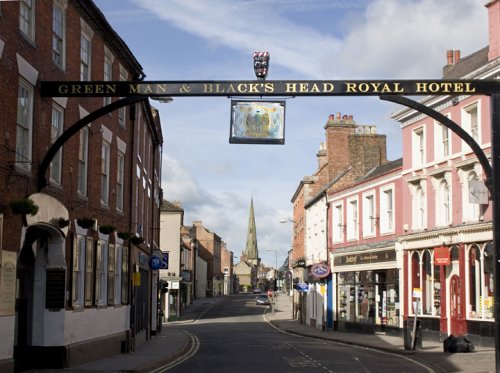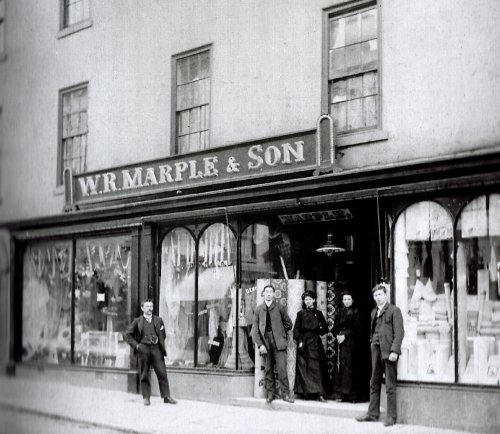In the 1830s, the Princess (later Queen) Victoria stopped here for a comfort break on her tour around Britain, and a later owner changed the name of the inn to “The Green Man and Black’s Head Royal Hotel”.
The Green Man was built in the 1750s to service the growing coaching trade in Ashbourne and was the Town’s premier coaching Inn. As the coaching trade reduced in the 1820s, the owner of the Green Man bought the neighbouring Blackmoor’s Head Inn – now the site of Costa Coffee, BHF Charity shop and Wigley’s Shoe Shop – and amalgamated the 2 inns into the Green Man and Black’s Head Inn. At this time, Ashbourne had no public meeting rooms and this Inn became the centre for public assemblies in the town, including entertainments and the local Magistrate and County Courts and latterly the Head Quarters to the Ashbourne Royal Shrovetide Committee.
In the 1830s, the Princess (later Queen) Victoria stopped here for a comfort break on her tour around Britain, and a later owner changed the name of the inn to “The Green Man and Black’s Head Royal Hotel”. Subsequently, the addition of “Commercial” allowed the owners to claim that it was the longest inn name in Britain. The railways brought the end to the lucrative coaching trade in Ashbourne; by 1846, there was only one through coach and all coaches had stopped by 1855. The Green Man continued to be a centre of social activities in Ashbourne until its recent closure for redevelopment. Its gallows inn sign across the road is one of the few left in Britain.
One of the main coaching inns in Ashbourne until bought by the owner of the Green Man in the 1820s. The original entrance door can be seen between Wigley’s Shoe Shop and the BHF Charity Shop. Ashbourne lacked a purpose-built assembly room and the Blackmoor’s Head was the venue for most of Ashbourne’s social assemblies until it closed. Assemblies were an essential feature of Georgian life and were held at regular intervals through the year.
The main activity of an assembly was an evening ball, held in a large room on the first floor, during which several formal set dances took place, whilst card games were played at side tables or in adjoining rooms. A writer described such assemblies as “the resort of the young and gay, who go to see and be seen; and also of those who, having played their matrimonial cards well in earlier life, are now content to sit down to a sober game of whist”. The role of assemblies in looking for suitable marriage partners features in Jane Austin’s novels.
Not every one visiting the Inn would have been in a good mood, though, as its assembly rooms were also used for the local magistrate and county courts.
James Boswell was a companion and biographer of Dr Johnson and visited Ashbourne with him when Johnson stayed at The Mansion. Boswell stayed at The Green Man.
Probably the best known of the 15 remaining Festival Football games played in Britain, the game at Ashbourne is takes place throughout the streets each year on Shrove Tuesday and Ash Wednesday. The boundary between the two teams, Upards and Downards, is the Scolebrook/Henmore Brook.
Mademoiselle d'Jacque, a 7.5 ton elephant, stayed in the Green Man in 1830.
















